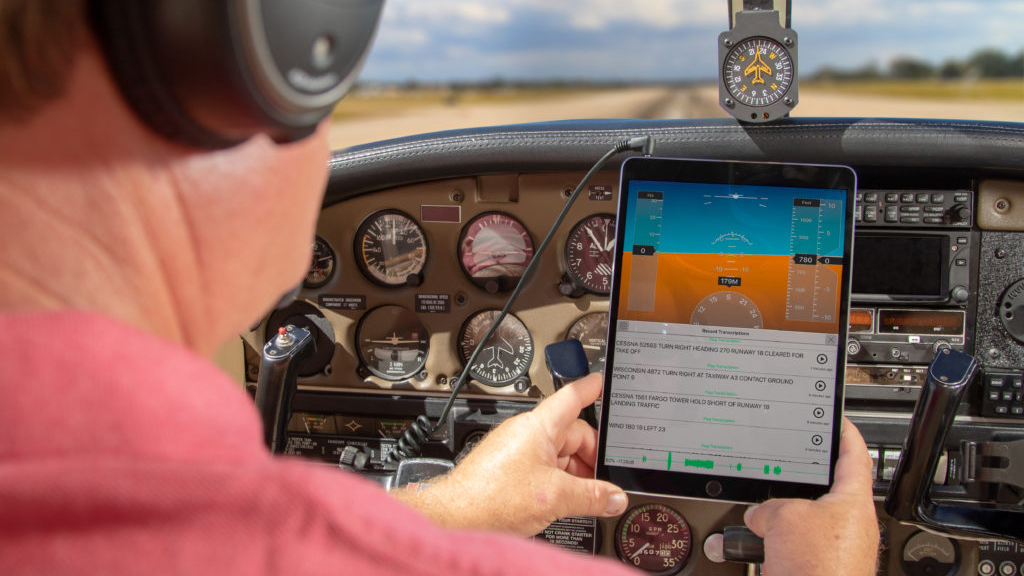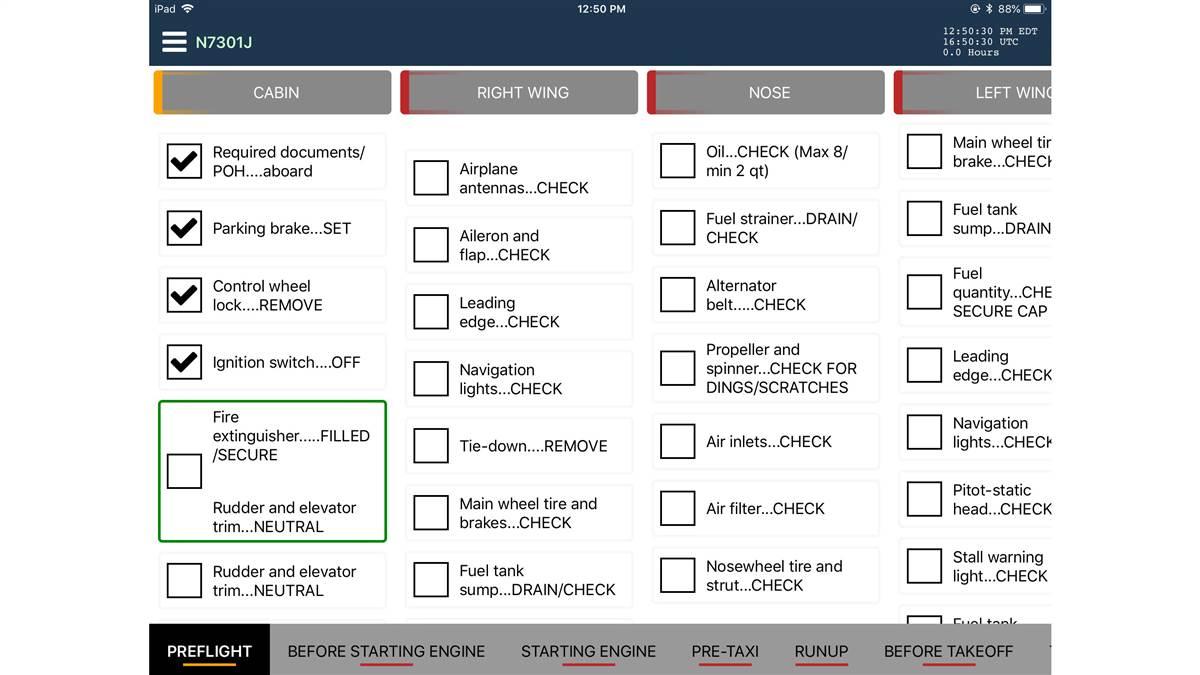Products: Appareo launches innovative Stratus app
Audio cable unlocks tablet’s potential in the cockpit

Both radio playback and radio transcription require a connection between the pilot’s iPad or iPhone and the aircraft’s instrument panel—a need that Appareo addresses with its new Stratus Audio Cable. The $49.99 accessory connects in line with the pilot’s headset, allowing the app to hear and, eventually, transcribe radio calls. The cable also will allow the pilot to hear traffic alerts, terrain warnings, and other aural advisories from electronic flight bags or flight management apps running on the device, such as ForeFlight.
The Horizon Pro displays supplemental attitude information driven by a Stratus receiver, which Appareo said essentially creates a backup glass cockpit on the iPad. The AHRS feature aligns itself automatically, and the responsive pitch and bank instrument within the app could provide an excellent backup for emergency situations.
“Pilots are going to love the ability to tap their iPad for a quick audio playback, rather than ask controllers to repeat themselves,” said Appareo Aviation President Kris Garberg. “But we’re not stopping there. We have more exciting features in development for this app.”
The radio transcription feature will work in the same way as visual voicEmail works. ATC communications are converted into text and displayed directly above the audio playback line, making it easy to reference previous audio clips. It’s driven by speech recognition and language understanding technology designed by Appareo’s Artificial Intelligence division.
The audio cable really is the key, said Zach Peterson, Appareo aviation sales manager. “Immediately what it does is it gives you audio playback.” And customers can apply to the beta test program for audio transcription. The system uses GPS location to determine the proper fix when there’s a duplicate name in the system, he added. “That’s where the future of transcription is going—to be smart enough to recognize where you are. It does not need to be connected to the internet; it’s completely self-supporting.”
For beta testers, he said the company is looking for pilots who fly a lot, and who operate in different parts of the country, to pull in variations and regional inflections. Beta testers’ audio files and transcriptions will upload automatically to Appareo when they have Wi-Fi connections.
The app will archive a couple hundred hours of recordings, which don’t take up much space, but the pilot can clear them at any time. A cabin filter function suppresses recording of the pilot and passengers—but this can be turned off if, for example, an instructor and student are working on radio calls; then it will capture the student’s transmission and the controller’s response.
Stratus Horizon Pro is designed to work with an iPad’s Split View, as well as the new multitasking feature that allows the use of two apps at the same time. This means pilots can have Stratus Horizon Pro displayed as a small overlay, while continuing to run their favorite EFB. The app can be viewed in day mode, night mode, or a HUD mode for those that have a head-up display.
Stratus Horizon Pro is available for free download from the Apple App Store, and the Stratus Audio Cable can be ordered online.
Email [email protected]
AOPA offers new Bahamas, Caribbean travel guides
 AOPA has released the 2019 editions of its comprehensive AOPA Pilot Guides for the Bahamas and the Caribbean. The publications have been an indispensable, trusted source of flight planning information for the islands for more than 35 years. Following the hurricane season of 2017, the tourism sectors of the islands are rebuilt and continue to see an increase in visits.
AOPA has released the 2019 editions of its comprehensive AOPA Pilot Guides for the Bahamas and the Caribbean. The publications have been an indispensable, trusted source of flight planning information for the islands for more than 35 years. Following the hurricane season of 2017, the tourism sectors of the islands are rebuilt and continue to see an increase in visits.
The guides help you plan your stay after arrival, with a wide range of destination information including phone numbers of hotels and popular attractions, details of local culture and food, and tips for how to get around the islands. You can also read the suggestions and advice of other pilots who have flown in to visit.
Digital editions of the guides are priced at $39.99 each. A printed guide bundled with a chart costs $48. The complete package of both guides and associated charts is priced at $92.
The Bahamas
From Grand Bahama to Great Inagua, the Bahamas guide covers the 58 airports in the Bahamas.
The Bahamas are a popular destination for pilots. It is a flight of slightly more than 50 nautical miles from southeast Florida to Bimini—the closest Bahamian island to the U.S.—and it takes an hour or less to reach many of the islands in a Cessna 172. Each island of the Bahamas has a different personality, making them great getaway destinations.
Nassau and Paradise Island are bustling with visitors by aircraft and cruise ships, with large resorts and plenty of activities. Abaco and the Exumas are a boater’s paradise with cays to explore—and don’t miss the swimming pigs on Staniel Cay. Bimini, Grand Bahama, Andros, Crooked Island, San Salvador, and Long Island are renowned for diving, snorkeling, and an abundance of fishing opportunities, with many lodges and guides available. Eleuthera is famous for its boutique hotels and beaches of coarse pink and powder-soft white sand. The uncrowded, peaceful beaches of Cat Island and Mayaguana offer a unique get-away-from-it-all experience.
The Bahamas welcomes visitors who arrive by general aviation aircraft, offering numerous GA-friendly fixed-base operators where the staff are happy to help you get out and enjoy the islands with ease.
The Caribbean
The Caribbean guide covers 85 Caribbean airports from the Cayman Islands in the west to Barbados in the east, and from the northernmost Turks and Caicos to Aruba, Bonaire, and Curaçao to the south.
Caribbean islands accommodate many tastes. Saint Maarten is known for its great nightlife. Savor Puerto Rico’s natural beauty and rich history. Dominica, with its hot springs, and the Dominican Republic are all about the outdoors, with hiking, watersports, and kite surfing. Saint Barth’s with its beautiful resorts is luxurious in the French fashion; Saint Vincent and the Grenadines are a boater’s paradise.
The Cayman Islands are home to the beautiful Seven Mile Beach and Sting Ray City. Speaking of beaches, visit the much-awarded Grace Bay in the Turks and Caicos; Barbados adds multiple horse races to Caribbean-style fun, including the prestigious Sandy Lane Barbados Gold Cup.
As in the Bahamas, there is an abundance of GA-friendly airports with FBOs that are excited to be your hosts.
For more information and downloadable forms for your flight, see the AOPA Pilot Guides: Bahamas and Caribbean page on AOPA Online.

MiraCheck CoPilot
Build your own checklist
By Jill W. Tallman
Created by pilot Jeff Bonasso, MiraCheck CoPilot lets you build for every phase of flight a custom checklist that you can store on an Apple or Android mobile device.
You can start from scratch and build the checklist of your dreams—the one that includes all the notes and tidbits and insights that you develop as you become familiar with an airplane. Or, you can borrow a template from one of several provided in the app, and then make that checklist your own.
If your device runs on iOS, you can have MiraCheck read off each task to you, just as an actual co-pilot would. The pleasantly modulated computer voice won’t progress until you’ve checked off each item. The free version of the app allows you to demo this feature, but you’ll need to pay additional for it if you want it for yourself.
As you move through tasks, each section’s color-coded progress changes: Red is not begun; yellow is begun but not completed; green is completed.
Voice prompts can take you to an emergency checklist; open and close notes and comments; open and close a logbook feature; and reset a section—or the entire checklist—if you desire.
You can also create a formal checklist that can take the place of a flight planner sheet—use it to gather weather information, runway details, radio frequencies, and the like. MiraCheck CoPilot lets you overlay a checklist on a flight planning app, so you can reference your checklist while checking an airport diagram, for example.
The checklist lives in the cloud and is synchronized to your device. You can create all kinds of checklists; the template includes a sample shopping list and some other ideas.
In setting up a checklist for my Piper Cherokee 140, I found it easier to create one on a computer rather than to fumble around on my iPad Mini. It took about an hour to build a preflight/startup checklist.
Most of the more popular flight planning apps include a checklist function, so if you’re using ForeFlight or Garmin Pilot you may not be tempted to stray. MiraCheck CoPilot offers functionality beyond those programs, such as the ability to overlay the checklist on top of any app; the ability to control the checklist with your voice; and control the checklist with an Apple watch, among many others.
The basic app is free, and it allows you to manage up to five checklists synced to one device.
MiraCheck CoPilot offers several price points that include extra features. The Standard plan ($29.99 one-time fee) lets you manage unlimited checklists and sync them across three devices, and it includes advanced layouts, night mode, and a check/skip/locate/emergency checkbar. The Pro plan, at $4.99 per month or $49.99 per year, lets you manage unlimited checklists synced across five devices, and it includes the voice-activated co-pilot and a history of all checklist sessions. The Pro Unlimited ($99 one-time fee) is basically the Pro plan.
Email [email protected]



